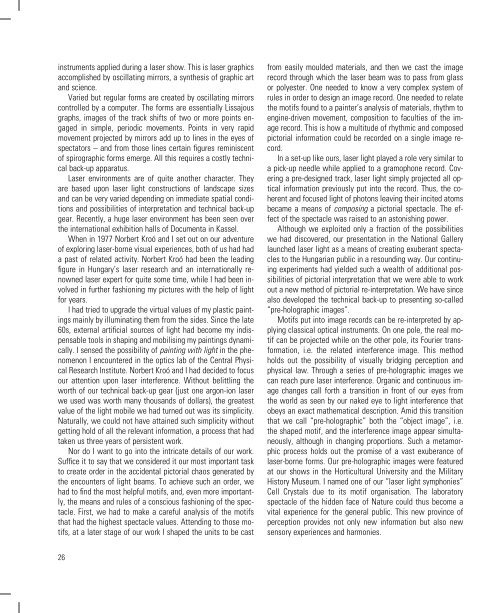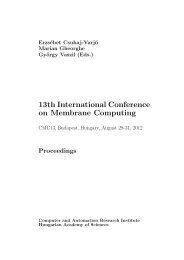Time on the Tilt
Time on the Tilt
Time on the Tilt
You also want an ePaper? Increase the reach of your titles
YUMPU automatically turns print PDFs into web optimized ePapers that Google loves.
instruments applied during a laser show. This is laser graphics<br />
accomplished by oscillating mirrors, a syn<strong>the</strong>sis of graphic art<br />
and science.<br />
Varied but regular forms are created by oscillating mirrors<br />
c<strong>on</strong>trolled by a computer. The forms are essentially Lissajous<br />
graphs, images of <strong>the</strong> track shifts of two or more points engaged<br />
in simple, periodic movements. Points in very rapid<br />
movement projected by mirrors add up to lines in <strong>the</strong> eyes of<br />
spectators – and from those lines certain figures reminiscent<br />
of spirographic forms emerge. All this requires a costly technical<br />
back-up apparatus.<br />
Laser envir<strong>on</strong>ments are of quite ano<strong>the</strong>r character. They<br />
are based up<strong>on</strong> laser light c<strong>on</strong>structi<strong>on</strong>s of landscape sizes<br />
and can be very varied depending <strong>on</strong> immediate spatial c<strong>on</strong>diti<strong>on</strong>s<br />
and possibilities of interpretati<strong>on</strong> and technical back-up<br />
gear. Recently, a huge laser envir<strong>on</strong>ment has been seen over<br />
<strong>the</strong> internati<strong>on</strong>al exhibiti<strong>on</strong> halls of Documenta in Kassel.<br />
When in 1977 Norbert Kroó and I set out <strong>on</strong> our adventure<br />
of exploring laser-borne visual experiences, both of us had had<br />
a past of related activity. Norbert Kroó had been <strong>the</strong> leading<br />
figure in Hungary’s laser research and an internati<strong>on</strong>ally renowned<br />
laser expert for quite some time, while I had been involved<br />
in fur<strong>the</strong>r fashi<strong>on</strong>ing my pictures with <strong>the</strong> help of light<br />
for years.<br />
I had tried to upgrade <strong>the</strong> virtual values of my plastic paintings<br />
mainly by illuminating <strong>the</strong>m from <strong>the</strong> sides. Since <strong>the</strong> late<br />
60s, external artificial sources of light had become my indispensable<br />
tools in shaping and mobilising my paintings dynamically.<br />
I sensed <strong>the</strong> possibility of painting with light in <strong>the</strong> phenomen<strong>on</strong><br />
I encountered in <strong>the</strong> optics lab of <strong>the</strong> Central Physical<br />
Research Institute. Norbert Kroó and I had decided to focus<br />
our attenti<strong>on</strong> up<strong>on</strong> laser interference. Without belittling <strong>the</strong><br />
worth of our technical back-up gear (just <strong>on</strong>e arg<strong>on</strong>-i<strong>on</strong> laser<br />
we used was worth many thousands of dollars), <strong>the</strong> greatest<br />
value of <strong>the</strong> light mobile we had turned out was its simplicity.<br />
Naturally, we could not have attained such simplicity without<br />
getting hold of all <strong>the</strong> relevant informati<strong>on</strong>, a process that had<br />
taken us three years of persistent work.<br />
Nor do I want to go into <strong>the</strong> intricate details of our work.<br />
Suffice it to say that we c<strong>on</strong>sidered it our most important task<br />
to create order in <strong>the</strong> accidental pictorial chaos generated by<br />
<strong>the</strong> encounters of light beams. To achieve such an order, we<br />
had to find <strong>the</strong> most helpful motifs, and, even more importantly,<br />
<strong>the</strong> means and rules of a c<strong>on</strong>scious fashi<strong>on</strong>ing of <strong>the</strong> spectacle.<br />
First, we had to make a careful analysis of <strong>the</strong> motifs<br />
that had <strong>the</strong> highest spectacle values. Attending to those motifs,<br />
at a later stage of our work I shaped <strong>the</strong> units to be cast<br />
from easily moulded materials, and <strong>the</strong>n we cast <strong>the</strong> image<br />
record through which <strong>the</strong> laser beam was to pass from glass<br />
or polyester. One needed to know a very complex system of<br />
rules in order to design an image record. One needed to relate<br />
<strong>the</strong> motifs found to a painter’s analysis of materials, rhythm to<br />
engine-driven movement, compositi<strong>on</strong> to faculties of <strong>the</strong> image<br />
record. This is how a multitude of rhythmic and composed<br />
pictorial informati<strong>on</strong> could be recorded <strong>on</strong> a single image record.<br />
In a set-up like ours, laser light played a role very similar to<br />
a pick-up needle while applied to a gramoph<strong>on</strong>e record. Covering<br />
a pre-designed track, laser light simply projected all optical<br />
informati<strong>on</strong> previously put into <strong>the</strong> record. Thus, <strong>the</strong> coherent<br />
and focused light of phot<strong>on</strong>s leaving <strong>the</strong>ir incited atoms<br />
became a means of composing a pictorial spectacle. The effect<br />
of <strong>the</strong> spectacle was raised to an ast<strong>on</strong>ishing power.<br />
Although we exploited <strong>on</strong>ly a fracti<strong>on</strong> of <strong>the</strong> possibilities<br />
we had discovered, our presentati<strong>on</strong> in <strong>the</strong> Nati<strong>on</strong>al Gallery<br />
launched laser light as a means of creating exuberant spectacles<br />
to <strong>the</strong> Hungarian public in a resounding way. Our c<strong>on</strong>tinuing<br />
experiments had yielded such a wealth of additi<strong>on</strong>al possibilities<br />
of pictorial interpretati<strong>on</strong> that we were able to work<br />
out a new method of pictorial re-interpretati<strong>on</strong>. We have since<br />
also developed <strong>the</strong> technical back-up to presenting so-called<br />
“pre-holographic images”.<br />
Motifs put into image records can be re-interpreted by applying<br />
classical optical instruments. On <strong>on</strong>e pole, <strong>the</strong> real motif<br />
can be projected while <strong>on</strong> <strong>the</strong> o<strong>the</strong>r pole, its Fourier transformati<strong>on</strong>,<br />
i.e. <strong>the</strong> related interference image. This method<br />
holds out <strong>the</strong> possibility of visually bridging percepti<strong>on</strong> and<br />
physical law. Through a series of pre-holographic images we<br />
can reach pure laser interference. Organic and c<strong>on</strong>tinuous image<br />
changes call forth a transiti<strong>on</strong> in fr<strong>on</strong>t of our eyes from<br />
<strong>the</strong> world as seen by our naked eye to light interference that<br />
obeys an exact ma<strong>the</strong>matical descripti<strong>on</strong>. Amid this transiti<strong>on</strong><br />
that we call “pre-holographic” both <strong>the</strong> “object image”, i.e.<br />
<strong>the</strong> shaped motif, and <strong>the</strong> interference image appear simultaneously,<br />
although in changing proporti<strong>on</strong>s. Such a metamorphic<br />
process holds out <strong>the</strong> promise of a vast exuberance of<br />
laser-borne forms. Our pre-holographic images were featured<br />
at our shows in <strong>the</strong> Horticultural University and <strong>the</strong> Military<br />
History Museum. I named <strong>on</strong>e of our “laser light symph<strong>on</strong>ies”<br />
Cell Crystals due to its motif organisati<strong>on</strong>. The laboratory<br />
spectacle of <strong>the</strong> hidden face of Nature could thus become a<br />
vital experience for <strong>the</strong> general public. This new province of<br />
percepti<strong>on</strong> provides not <strong>on</strong>ly new informati<strong>on</strong> but also new<br />
sensory experiences and harm<strong>on</strong>ies.<br />
A few m<strong>on</strong>ths ago I published an article in Új Írás (New<br />
Writing) <strong>on</strong> <strong>the</strong> many potential applicati<strong>on</strong>s of our laser light<br />
mobile. I now want to menti<strong>on</strong> just <strong>on</strong>e of those potential applicati<strong>on</strong>s.<br />
Perhaps <strong>the</strong> most varied applicati<strong>on</strong> of <strong>the</strong> metamorphic<br />
process provided by our laser light mobile offers itself<br />
in <strong>the</strong> <strong>the</strong>atre. Pi<strong>on</strong>eered by <strong>the</strong> Bauhaus movement, light <strong>the</strong>atre<br />
can not <strong>on</strong>ly produce additi<strong>on</strong>al lighting effects by introducing<br />
lasers, it can also provide an extremely varied light accompaniment,<br />
never before accomplished by any technical<br />
means, that can generate a <strong>the</strong>atrical envir<strong>on</strong>ment in its own<br />
Superposed recordings or pre-holographic images, 1980<br />
“Cell Crystals”<br />
right. By light <strong>the</strong>atre I do not mean an overdose of lighting<br />
effects designed to crush both <strong>the</strong> audience and <strong>the</strong> play performed<br />
but an organic, many-faceted kind of co-operati<strong>on</strong> that<br />
enhances <strong>the</strong> audience’s resp<strong>on</strong>se to <strong>the</strong> inner workings of<br />
<strong>the</strong> play precisely with <strong>the</strong> help of c<strong>on</strong>sciously designed visual<br />
processes. The job of a visual designer here is very similar to<br />
that of a composer.<br />
On <strong>the</strong> open-air stage of Székesfehérvár’s Vörösmarty Theatre<br />
this last summer we made <strong>the</strong> first steps towards <strong>the</strong> <strong>the</strong>atrical<br />
applicati<strong>on</strong> of lasers. True possibilities were raised<br />
26 27
















